There is no better way to improve your audiophile system than to address the physical acoustical issues found in your listening room. And do you have them? Yes, my friend, you do. So do I. In fact, my room is a wholesale acoustical disaster, if the truth be told. I am writing about that exact topic for an upcoming Featured News story here on FutureAudiophile.com, but I am about to give you some insight into how I easily solved one of my worst acoustical problems without spending very much money.
In my current reference audiophile system, I have a pair of beloved Bowers & Wilkins 802 D4 speakers in white that are the same speakers (one down from the 800s, but who’s counting) used at Abbey Road Studios, and at Skywalker Ranch here in California. They are fine speakers, as Andy Kerr and his team are total rock stars, who are very proud of the work that they do. What I do to their speakers is less proud, sadly, as I have one speaker in a corner and another one out in open air. I have one speaker with mostly glass on the side wall, when the other has no side wall whatsoever. Worse yet, my back wall is a mere 12 inches from my head/ears when I am in my chosen seating position. My room simply sucks acoustically. I don’t hate it, and I can make very respectable sound, despite the physical acoustical shortcomings.
In recent years, I have learned to listen far more quietly but in recent weeks/months, I have reverted back for some short sessions of much louder listening, which highlighted a malady that I was able to fix digitally in my Anthem STR preamp via Anthem Room Correction. which is a big-ass bump in the lower and mid-bass. This isn’t an uncommon problem for audiophiles, but it is rarely dealt with correctly, as most stereo stores ignore the importance of acoustics in hope of selling more expensive cables, components and whatnot.
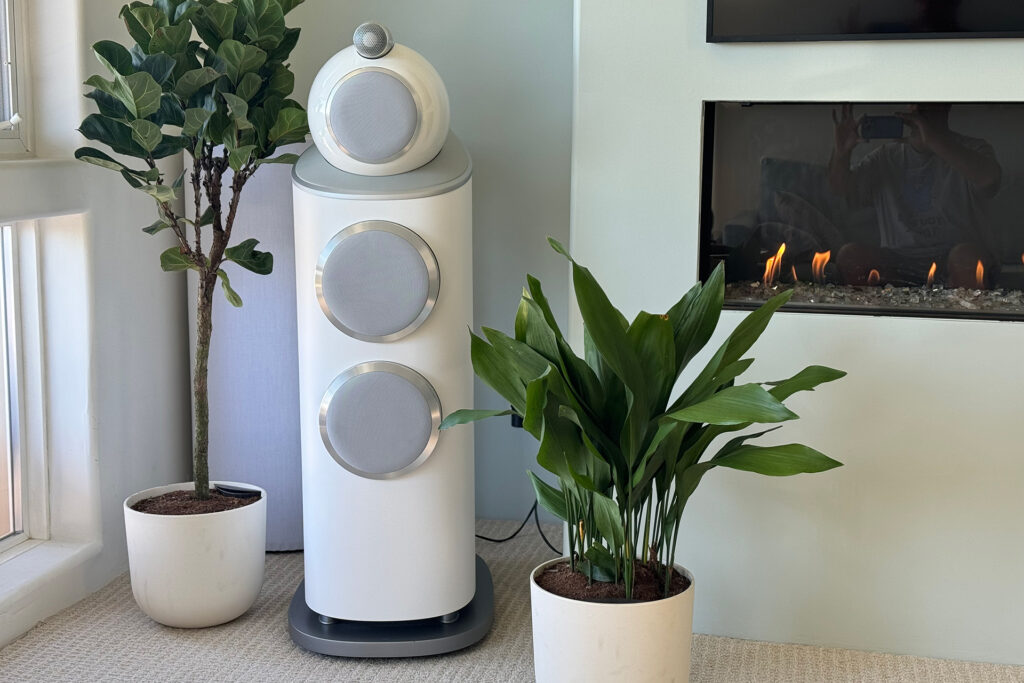
A few weeks ago, I received a GIK Acoustic Turbo Trap Pro bass-mitigating acoustical treatment. This somewhat heavy, round (and, in my case) white cylinder is designed to do one thing and one thing only, which is eat bass energy. Lower-frequency sound is a longer sine wave and can get loaded in a corner, as is the case with my left speaker. I carefully hoisted this 22-pound, $369 wool-mineral material-loaded, fabric-wrapped sucker behind my Bowers & Wilkins 802 and did some listening. Can a $369 bass trap solve real-world audiophile acoustic issues? That’s what we are here to discuss in this review …
What Makes the GIK Turbo Trap Pro So Special?
- The GIK Acoustics Turbo Trap Pro is a very attainable solution for any audiophile. Sold online at remarkably fair prices, the GIK Acoustics Turbo Trap Pro can fit into nearly any audiophile’s system without causing a high net worth divorce like many other acoustical treatments often can incite. At 17 inches wide and 35 inches tall, the GIK Acoustics Turbo Trap Pro needs to have enough size to eat big bad bass waves, but they aren’t so big that they dominate your room physically.
- Technologically, the magic behind the GIK Acoustics Turbo Trap Pro is the DDM. This is based around a carefully chosen and tested wool-mineral material that lives inside of a modestly tall, circular tower that has a singular purpose, which is to eat up nasty-ass bass waves. That’s all it does, and that is perfectly fine in that, if you can solve issues like a bump in your low to lower-mid frequencies in the physical domain, you are well on your way to getting a much better-sounding audiophile system without breaking the bank. When was the last time an establishment audiophile print magazine told you how to make your system significantly better without inserting a component for $20,000 made in Switzerland … but I digress.
- The GIK Acoustics Turbo Trap Pro is Class-A fire-rated, as a fabric-covered, wool-mineral material-filled acoustical treatment could potentially be a fire hazard but isn’t. The GIK Acoustics Turbo Trap Pro is professionally tested so that it will not be any kind of meaningful fire hazard.
- Unlike a good 40-ounce malt liquor (served cold and preferably wrapped in a brown paper bag), there is no formaldehyde in the GIK Acoustics Turbo Trap Pro bass traps. They are also using some more green internal acoustical material, which is respectable and quite welcomed.
- There are all sorts of finish options, including multiple wood veneers, as well as fabric color options. I went full Miami Vice package (think: Sonny Crocket in his slick 1980s nicely tailored Versace suit), meaning all white, which matches my speakers and blends in with some but not all of the colors of the walls, so my trap visually blends in nicely. I don’t need wife approval (literally, there was a clause in my prenup on this topic, and no, I am not kidding) about audio gear. However, I did check with her to see what she thinks of my GIK Acoustics Turbo Trap Pro and not only can she clearly hear the difference, but she says you can barely see them, so they are a win-win.
- GIK is willing to consult you on your room acoustics issues. You could have a PhD and not know as much about how to make your audiophile room sound better as the team at GIK, and they are willing to help you for free. Are they trying to sell your more room treatments? Yes, but they are pretty subtle about it. I find them much more consultive and partner-like than even a modicum of pushy. This is a wonderful added value, as bass traps are only part of the acoustical solution in most audiophile rooms.
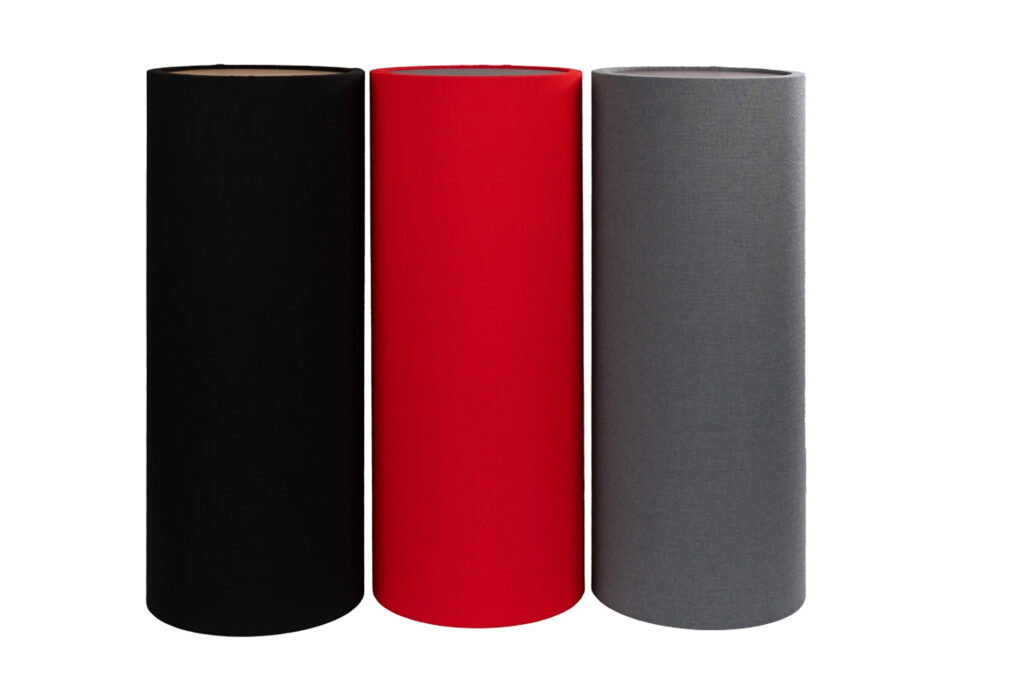
Why Should Your Care About the GIK Acoustics Turbo Trap Pro?
Everybody should care about what the GIK Acoustics Turbo Trap Pro can do, because nearly everybody has issues with low-frequency bass energy loading up in their room. So many of us audiophiles have this acoustical challenge, and a bass trap is the fastest, least expensive way to attack your acoustical problem in the real world. Will you use digital room correction? Most audiophiles don’t at this point, but I do when not specifically reviewing a component. With products like the new BlueSound Node 2024 boasting Dirac Live capabilities coming in early 2025, there will be more audiophiles that are using digital room correction. Let me be clear with you: dealing with your acoustical issues in the physical domain first makes for a far better sonic audiophile outcome. It just does.
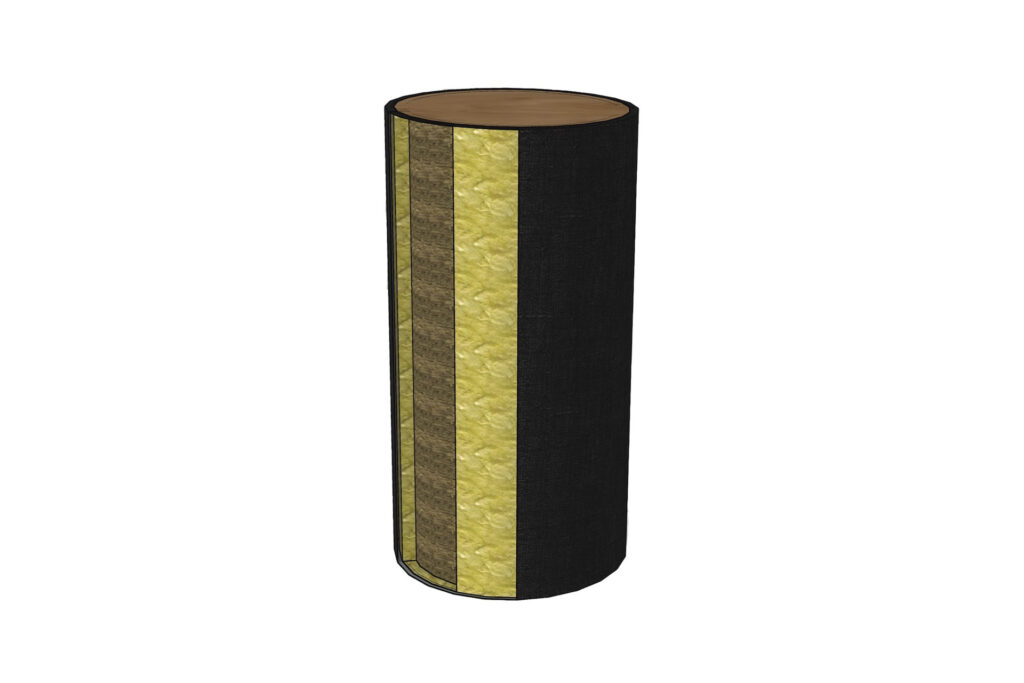
Some Things You Might Not Like About the GIK Acoustics Turbo Trap Pro
- In a perfect world, nobody would need to add a 35-inch tall by 17-inch wide room treatment or two (or four or more). But we don’t live in a perfect world, do we? In the real world, there is no faster or less expensive way to solve the very common audiophile malady, so finding a way to fit in a pair of these room treatments is likely a good idea, even if it requires consulting from an interior decorator.
- While not ugly or visually objectionable in any way, the GIK Acoustics Turbo Trap Pro is not a gorgeous piece of audiophile jewelry. At $369, there isn’t much budget for exotic finishes and/or other fancy window dressing, which seems to make sense.
Listening to the GIK Acoustics Turbo Trap Pro …
When I was in music school in the mid-1990s, my professor owned the studio where Barry White recorded the album The Icon is Love, thus I’ve had the chance to hear this record from the master tape on the tape machine that it was recorded on. It was a very impressive experience, especially in the bass department, which makes it a strong track to test the GIK Acoustics Turbo Trap Pro. On “There It Is” (from QoBuz) in my system, the low end of the track, when at a loud but not harmful volume, the bass had a bloat to it that wasn’t anything like I heard in the studio. I carefully placed the GIK Acoustics Turbo Trap Pro over the top of my Bowers and Wilkins 802 D4 floorstanding speakers and voila … that sonic bloat had a huge bite taken out of it. The effect was immediate and obvious, as well as affordable. I had my wife come over and hear the difference, as she is a budding audiophile, and she too thought the difference was easily audible and quite the upgrade. For the cost of two or three 180-gram vinyl records, any audiophile can tighten up their bass, which is a very fair value proposition.
The drum sound on “Nothing at All” by Foo Fighters’ But Here We Are album from QoBuzshowed how much sonic improvement there was with the GIK Acoustics Turbo Trap Pro in the loop. I started this one with the GIK Acoustics Turbo Trap Pro in place, and then removed it. I didn’t like it gone. Not one bit. The drums were so much more tight-sounding with the GIK Acoustics Turbo Trap Pro in the corner behind my left speaker. There were other benefits higher up the frequency range, too. Everything seems to have a little more coherence, not just the bass. The sonic difference wasn’t small.
Will the GIK Acoustic Turbo Trap Pro Hold Its Value?
Nope. The GIK Acoustics Turbo Trap Pro isn’t going to hold any real-world value, but at the same time, at barely over $350, this audiophile gem won’t owe you a penny when you are someday potentially done with it. It does one task, and does it notably well, and for a nearly impossible price. If you upgraded to a better room or a more expensive option, like some RPG Modex Plates, then you likely would give away your GIK Acoustics Turbo Trap Pros to another audiophile, who might be in need of a nice tweak to his or her system. Also, the dimensional weight of a GIK Acoustics Turbo Trap Pro make shipping a bit costly, unless you’ve got one hell of a discount with your favorite shipping company. Simply put, the resale value of this product isn’t relevant, as you will consume every penny of value from this product in a matter of weeks of listening.
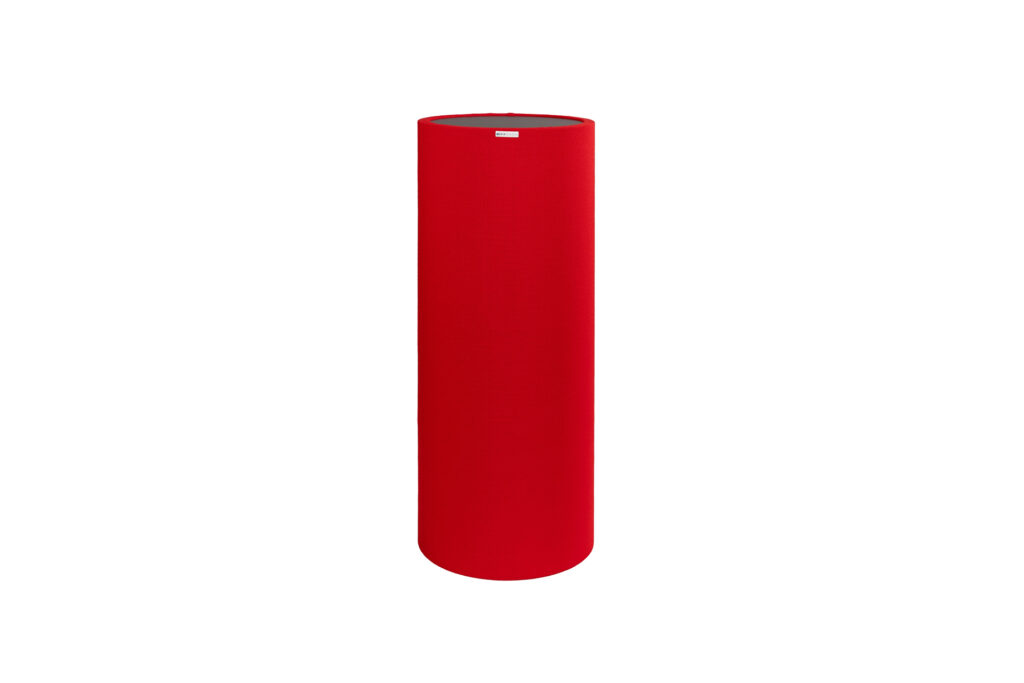
What Is the Competition for the GIK Acoustics Turbo Trap Pro?
ASC Tube Traps, of various sizes and configurations, come to mind first when talking about competition for the GIK Acoustics Turbo Trap Pro. Before this review, I called ASC. I did business with their founder, Art Noxon, years ago, and I was shocked at the way that I was treated. I didn’t ask for anything for free, but I did ask to buy the product, and I was offered a price that was significantly above dealer cost, which is downright insulting, and the attitude that I got from their staff made me just give up on their products completely. ASC room acoustics products are more expensive than GIK, and I have never experienced an improvement in sound in the rooms that I have heard. I would have liked to done an A-B test, but that clearly wasn’t in the cards with Art’s new staff. ASC also promotes the use of many multiples of cylindrical towers that are just not as visually appealing to any audiophile’s eyes. I think this company, sadly, misses its founder and has lost its way a bit.
RPG’s Modex Plate 2.0 (about $1,600 each) is perhaps the best bass-absorption solution that I’ve ever used, but they come with a heavy price and installation grief. In my former home in Brentwood (the next canyon over from Kamala, and up the hill from Governor Arnold), I built a dedicated listening room with the help of acoustical designer Bob Hodas and speaker engineer Kevin Voecks, which was installed by Simply Home Entertainment. We used all sorts of RPG treatments that ALL were hidden by a fabric wall. Most relevant to this review is the RPG Modex Plate 2.0, which is a rectangular device that goes in your stud bay of your wall. It therefore requires some messy, complicated and likely professional installation. The RPG Modex Plate 2.0 is very effective at its job and, while it needs to be covered by something like a fabric wall, it also takes up zero floor space, which is a huge advantage. On the other hand, this is not really a DIY project for most audiophiles, but it is one hell of a solution to standing bass waves in the corners of your listening room.
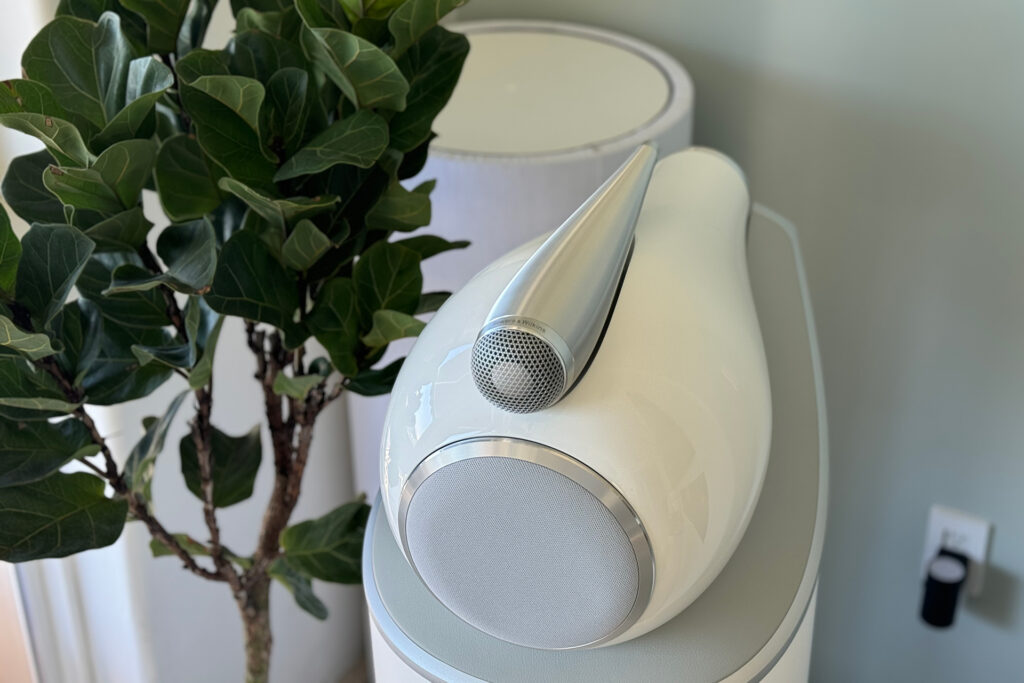
Final Thoughts on the GIK Acoustic Turbo Trap Pro …
You couldn’t pry my GIK Acoustics Turbo Trap Pro out of my hands, even if you clobbered me over the head with an audiophile-approved tire iron. In fact, I am ordering another one to sit behind my other speaker, now that I have learned that it can help other bass issues, even in open air. I’ve recently installed some medium-sized house plants that will make hiding a white tower pretty easy, and the performance improvement, even if small from this addition, is so worth the money that I can’t resist.
Far too often, traditional audiophile magazines are telling you how to spend thousands if not tens of thousands of dollars, as if that isn’t a lot of money. Friends, let me be clear, that’s a lot of money, and not everybody can (or wants to) spend that much money improving their system. Nor do any of us have to, as there are solutions like the GIK Acoustics Turbo Trap Pro that are highly sonically effective, and even more cost-effective.
Simply put, nearly every audiophile can benefit from what the GIK Acoustics Turbo Trap Pro does, and nearly every audiophile can afford a pair of these room treatments. Physics makes these room treatments very much worth their asking price and, when you get your bass more dialed-in, expect to hear benefits in higher frequencies, which is really cool. I am not normally this effusive about an audiophile system upgrade, but this one is so good and so affordable, I can’t help but to be highly enthusiastic. I don’t see how you can lose with a pair of these parked near your favorite audiophile speakers.




I have been using GIK bass traps, reflection panels, absorption panels and quadratic diffusion panels for almost five years now and the difference they made was outstanding. The GIK website has a lot of very useful information about what causes problems in audio room and how to correct them. And as the article pointed out, they are modestly priced, which is a real plus these days.
I have four GIK soffit bass traps installed floor-to-ceiling behind my speakers. The bass definition is both deep and well defined. This is the single best improvement to my room by far.
I agree with you.
Dollar for dollar you can’t do better than this for an upgrade to your audiophile system.
And as much as I love room correction and I do – getting your physical room dialed in is the first step.
What are your thoughts re treatment of the wall a foot behind your head? Diffusion, absorption, or cutting the wall away?! That first reflection can be a mean one.
Absorption. Diffusion requires a significant amount of space from surface to listener to work as it should.
Being a cheap audiophile & deaf in my left ear (due Menieres disease), I solved this problem in both an easy & hard way. Because of the deafness, two years ago I decided to go from a conventional symmetrical room layout to right sided with, the speakers separated by 3ft to still give the sound some dimensionality. 1. Hard) I gathered some acoustic bass CDs & listened (making notes) at three different locations near the right room corner for at least a week each. Once I settled on the best location, 2. Easy) I used port stuffers (waste disposal rubber bungs from Home Depot) for overly bassy recordings. I havn’t used the stuffers recently, I must be getting used to the sound. Cheers!